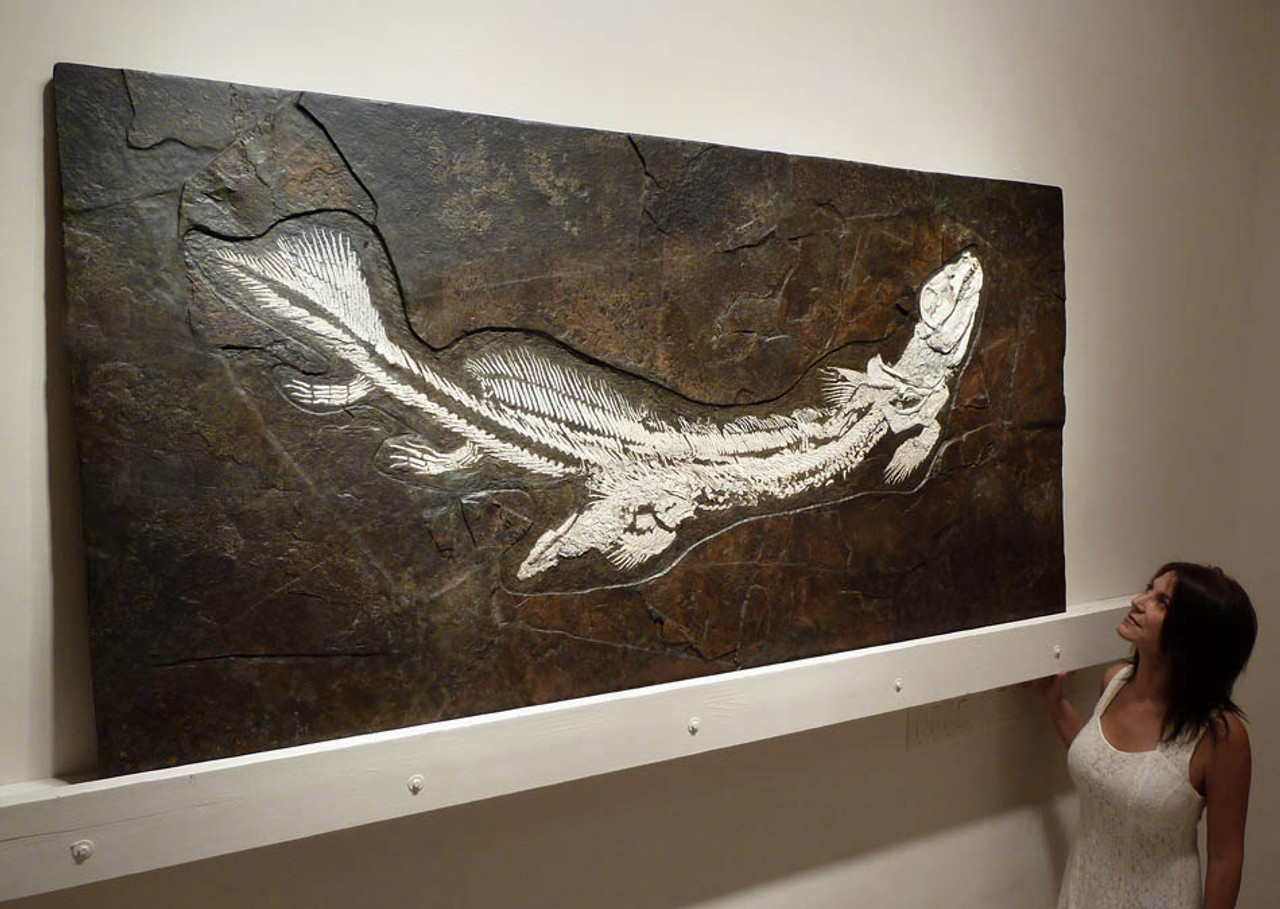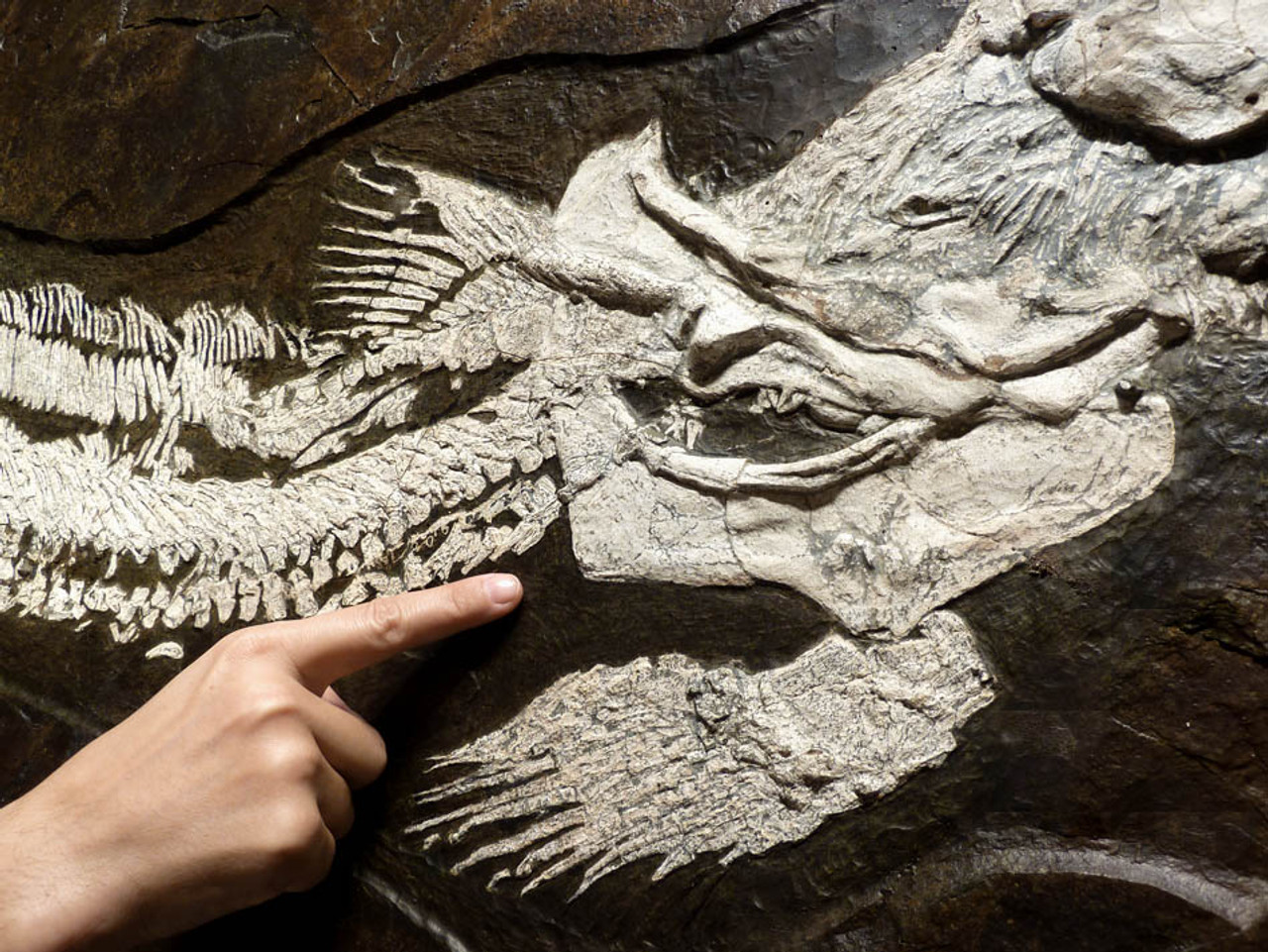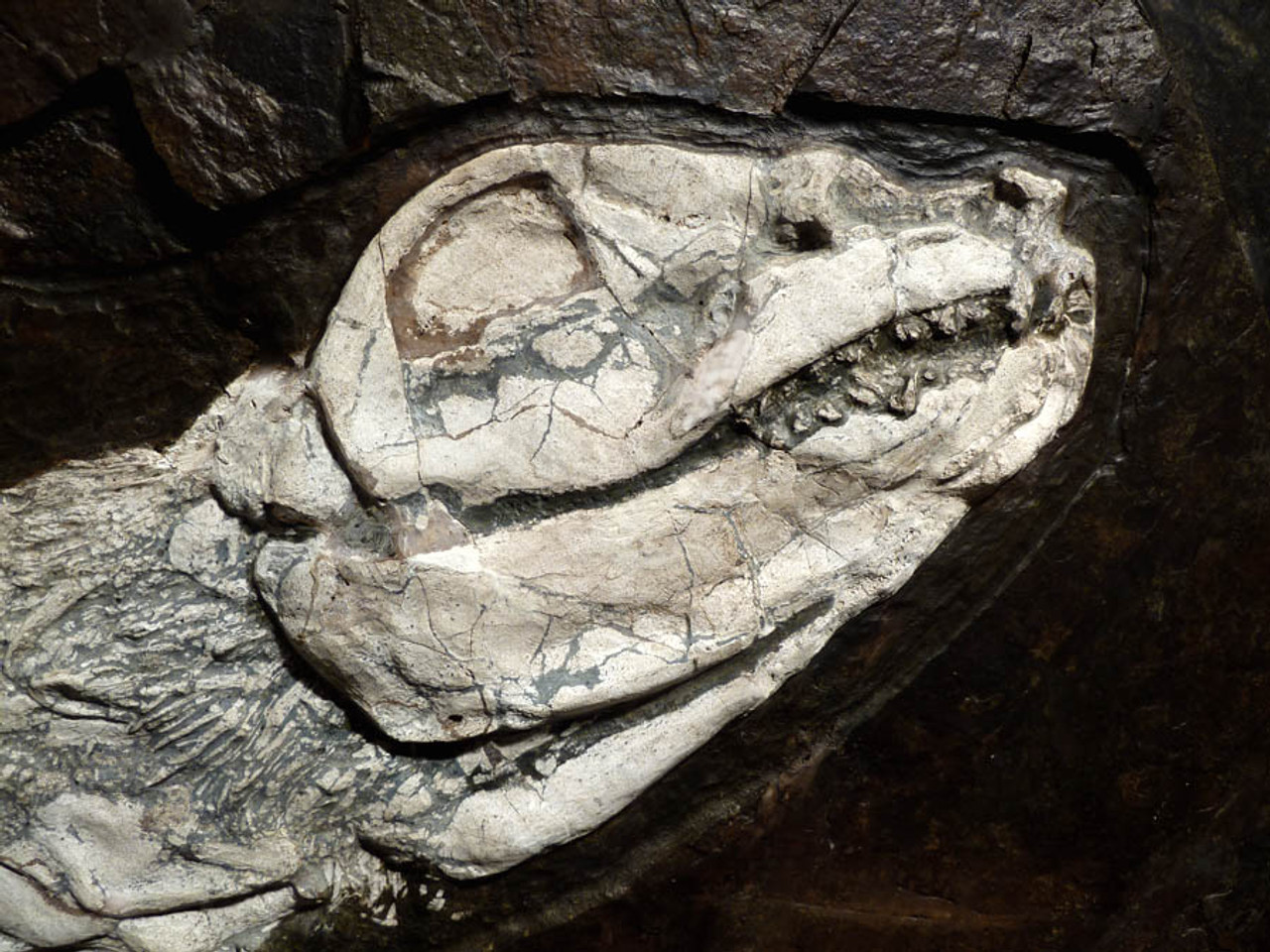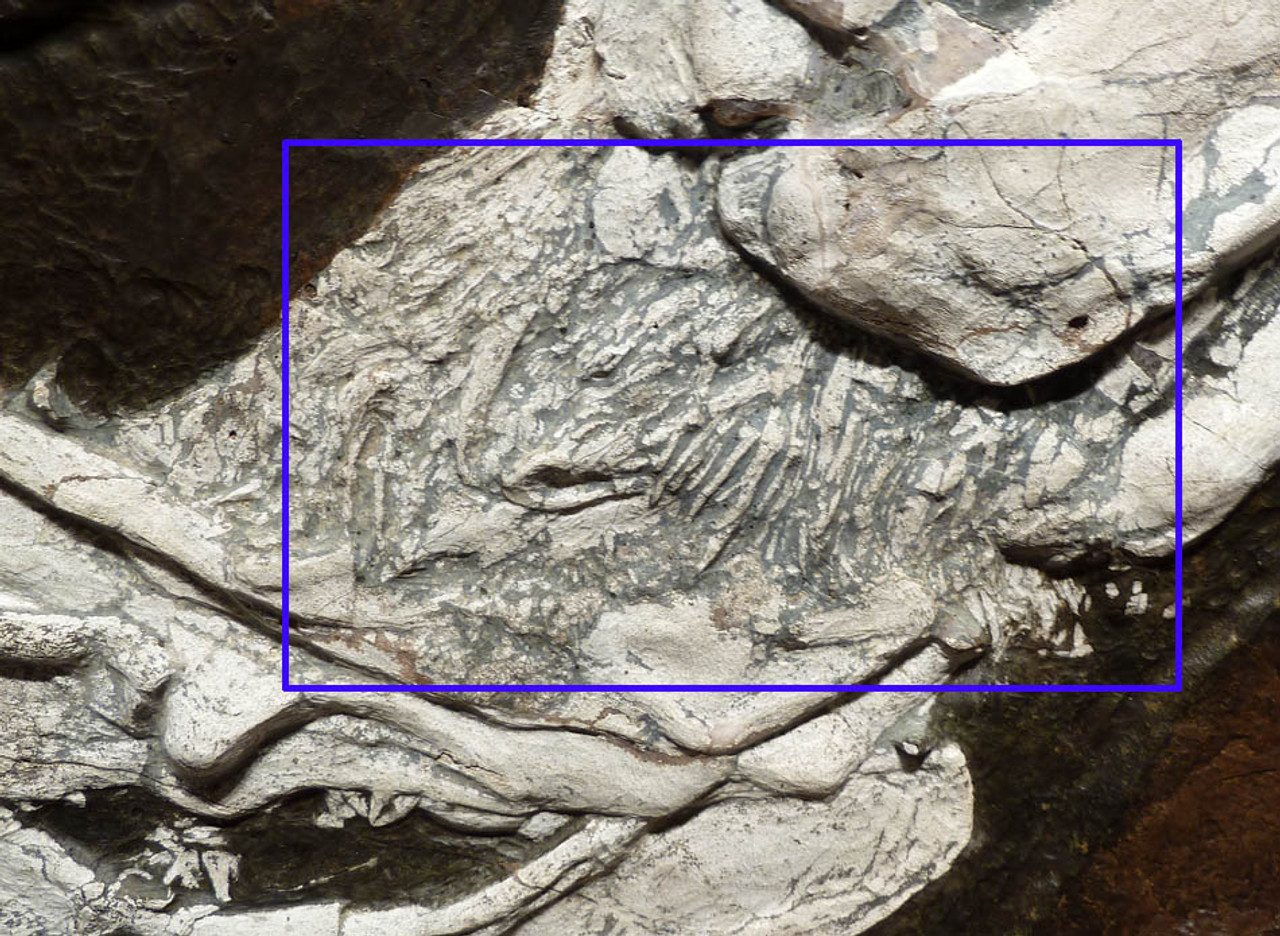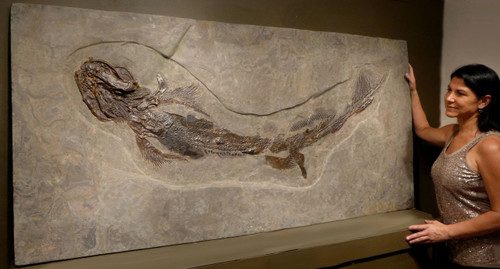Product Description
ITEM #
|
F085
|
||
ID
|
Orthachanthus
|
||
FOUND
|
Rheinland Pflaz, Germany
|
||
AGE
|
PERMIAN: 260 million years ago
|
||
SIZE
|
82.5" long by 41" overall, shark is 74.5" long
|
||
CONDITION
|
100% ORIGINAL SHARK WITH NO COMPOSITING
|
||
NOTE
|
THE FINEST EXAMPLE WITH COLOR, POSE,
|
||
Actual Item - One Only
Comes with a certificate of authenticity / information sheet |
|||
After 2.5 years of preparation in our lab, we are proud to present what we believe to be one of the finest known scientific-grade specimens of this extremely rare primitive shark. This is a nearly 2 meter long COMPLETE and IMPECCABLY preserved Orthacanthus senckenbergianus shark from the Permian Period, 260 million years ago before the first dinosaur walked our planet. Any experienced paleontologist or well-traveled museum visitor of all the major institutions in the world will recognize that this is probably one of the finest known fossils of this rare apex predator for a number of reasons. From a scientific perspective, you CANNOT find a better specimen for not only its complete and amazing preservation, but its pose is a rare IDEAL SCENARIO because it allows the viewer to see ALL the anatomy of the shark is present, such as the rare presence of BOTH pectoral fins and a graceful, upward flying pose as if this shark is swimming just overhead, revealing the best angle to see every skeletal detail.
The preservation you see above is 100% original with NO FABRICATION to the skeleton or compositing of multiple skeletons to make one. This is the original and complete skeleton of a single, very large Orthacanthus shark. Typical to this type of fossil, the shark was excavated in pieces in the shale layers so the cracks have been filled and blended to the fossil. We opted to keep the majority of the surrounding rock in its natural split layer state on the surface. The area immediately around the shark was removed in the nature it would occupy if the shark still had its soft tissue (see model image below).
The method of preparation we used retained and exposed all of the anatomical detail in its original multi-dimensional nature. That said, many of these fossils do not possess such high relief in the skeleton but this particular example shows such eye-popping relief and inflation of the bones that it surpasses nearly every example we know of in major academic collections. Special mention is due in the pectoral region as well as the head. The teeth are still articulated in the skull and the mandible protrudes dramatically off the original stone plate it was found in.
The white color of the skeleton is natural and has NOT been painted and is 100% NATURAL. Every fin is present and in stunning, complete preservation. This is a MALE shark and is identified by the VERY RARE occurrence of UNUSUALLY LARGE left and right claspers, seen on the ventral region just anterior to the anal fins. These claspers, like every other bit of skeletal detail, were prepared by our staff with very high 3D relief as seen above in the images.
As stated, we performed the entire preparation to this fossil so we can fully attest to all the work done. The nature of how these fossils are prepared are most time and work intensive. Every little detail must be ground out by hand, carefully removing all matrix covering the white fossil skeleton. The color of the fossil is completely natural. Many of these specimens are hastily prepared by simply grinding a level layer off of the top of the fossil, often destroying much of the original anatomy. Unlike such an expedient but inferior method, we carefully removed the overlying matrix completely around the three-dimensional anatomy of the entire fossil surface, exposing superb multi-layered detail of the original exquisitely preserved skeleton and skull. The surrounding matrix was treated with a stone sealer that brings out a most incredible natural deep, dark forest-olive green and unique to this piece, the addition of red, orange and gold colors in the stone. This natural rich color in the shale offers the most impressive aesthetics to the natural white of the fossil shark skeleton.
Entire slab is reinforced with fiberglass and varies from 1" - 2" in thickness, overall. The slab is secure and safe for a custom wall mount application.
This specimen represents an investment opportunity in acquiring what few if any national museum in the world possesses in their collection inventories not to mention a private collection. When a rare fossil is of the finest grade from a scientific perspective AND presents an unforgettable experience in its visual magnificence to all that stand before it, then this is the making of a true treasure of any realm of rare objects. Many rare fossils are not visually impressive and many visually impressive fossils are not rare. This is one of those RARE prize discoveries that is BOTH! A rare fossil of this caliber that appeals and intrigues ALL viewers, even those with not a care for natural history, translates into a piece that will be an investment every bit as promising as the rarest gem or original work from a famous art master. Pieces like this shatter the normal boundaries of buyer demand for natural history objects alone - they are simply treasures of world interest and intrinsic value. Even the rarest objects of man-made art cannot boast of having the perfect marriage of PRICELESS INTRINSIC VALUE AND IMMEASURABLE BEAUTY that once was a living and breathing creature of our planet. This shark was an APEX PREDATOR WITH NO EQUAL, from a time before the dinosaurs.
From a period in time before the dinosaurs even walked the earth, the bizarre Orthacanthus thrived in prehistoric swamps and bayous in Europe and North America. The Orthacanthus was an ancient freshwater shark that is no longer in existence. It had a very long spine protruding from the back of the head followed by a long ribbon-like dorsal fin that gave it the appearance of an eel. The double forked teeth were another unique characteristic. A full grown Orthacanthus is believed to have grown to 10 feet in length and was THE most dangerous apex predator that terrorized all creatures that lived in its environment.
SPECIAL NOTE: The current laws in this state of Germany have forbid the collection of these remarkable fossils since 1986. This legislation has permanently ended the supply of such magnificent specimens such as this one being offered here. This rare example was originally collected years prior to the ban but remained unprepared until very recently when we acquired the specimen from the original collector and performed all the preparations ourselves. With digging in the formation now off-limits, a specimen such as this is sure to appreciate in value as an incredibly promising investment as well as leave speechless everyone who has the pleasure to experience it in person. Specimens like this are true international natural history treasures - exceedingly rare in any collection of this quality of preservation as well as execution of its preparation.
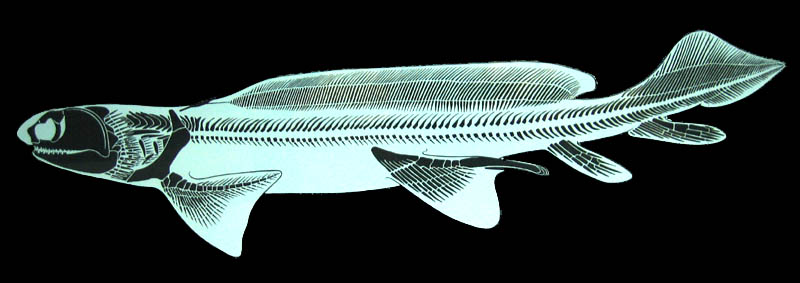
 US DOLLAR
US DOLLAR
 EURO
EURO
 AUSTRALIAN DOLLAR
AUSTRALIAN DOLLAR
 CANADIAN DOLLAR
CANADIAN DOLLAR
 POUND STERLING
POUND STERLING


